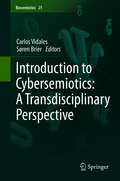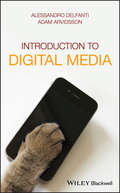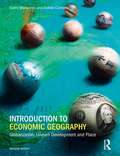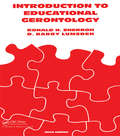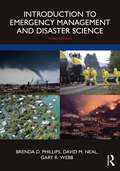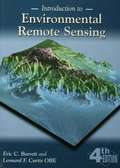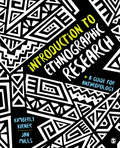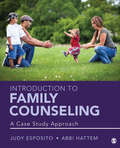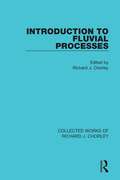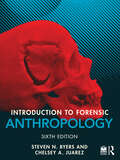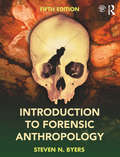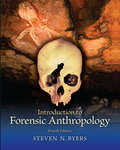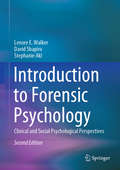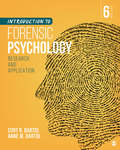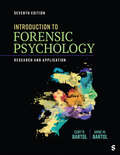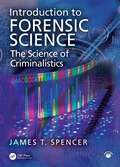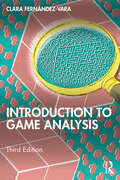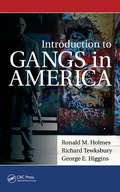- Table View
- List View
Introduction to Cybersemiotics: A Transdisciplinary Perspective (Biosemiotics #21)
by Carlos Vidales Søren BrierThis book traces the origins and evolution of cybersemiotics, beginning with the integration of semiotics into the theoretical framework of cybernetics and information theory. The book opens with chapters that situate the roots of cybersemiotics in Peircean semiotics, describe the advent of the Information Age and cybernetics, and lay out the proposition that notions of system, communication, self-reference, information, meaning, form, autopoiesis, and self-control are of equal topical interest to semiotics and systems theory. Subsequent chapters introduce a cybersemiotic viewpoint on the capacity of arts and other practices for knowing. This suggests pathways for developing Practice as Research and practice-led research, and prompts the reader to view this new configuration in cybersemiotic terms. Other contributors discuss cultural and perceptual shifts that lead to interaction with hybrid environments such as Alexa. The relationship of storytelling and cybersemiotics is covered at chapter length, and another chapter describes an individual-collectivity dialectics, in which the latter (Commind) constrains the former (interactants), but the former fuels the latter. The concluding chapter begins with the observation that digital technologies have infiltrated every corner of the metropolis - homes, workplaces, and places of leisure - to the extent that cities and bodies have transformed into interconnected interfaces. The book challenges the reader to participate in a broader discussion of the potential, limitations, alternatives, and criticisms of cybersemiotics.
Introduction to Digital Media
by Adam Arvidsson Alessandro DelfantiThis book introduces readers to the vast and rich world of digital media. It provides a strong starting point for understanding digital media’s social and political significance to our culture and the culture of others—drawing on an emergent and increasingly rich set of empirical and theoretical studies on the role and development of digital media in contemporary societies. Touching on the core points behind the discipline, the book addresses a wide range of topics, including media economics, online cooperation, open source, social media, software production, globalization, brands, marketing, the cultural industry, labor, and consumption. <p><p> Presented in six sections—Media and Digital Technologies; The Information Society; Cultures and Identities; Digital Collaboration; Public Sphere and Power; Digital Economies—the book offers in-depth chapter coverage of new and old media; network infrastructure; networked economy and globalization; the history of information technologies; the evolution of networks; sociality and digital media; media and identity; collaborative media; open source and innovation; politics and democracy; social movements; surveillance and control; digital capitalism; global inequalities and development; and more.
Introduction to Disability Studies
by David JohnstoneAn introductory text that explores the current issues in the lives and circumstances of disabled people, their careers, and those who intend to work in the caring services. Explores and analyzes quality of life factors, the emergence of rights, and the strengths and weakness of community care provisions. Also provides examples of individual oppressions and success stories, and suggests how disabled and non-disabled people can collaborate in the development of inclusive communities and neighborhoods. Distributed by Taylor & Francis. Annotation c. by Book News, Inc., Portland, OR.
Introduction to Economic Geography: Globalization, Uneven Development and Place
by Andrew Cumbers Danny MackinnonToday's rapidly flowing global economy, hit by recession following the financial crisis of 2008/9, means the geographical economic perspective has never been more important. An Introduction to Economic Geography comprehensively guides you through the core issues and debates of this vibrant and exciting area, whilst also exploring the range of approaches and paradigms currently invigorating the wider discipline. Rigorous and accessible, the authors demystify and enliven a crucial subject for geographical study. Underpinned by the themes of globalisation, uneven development and place, the text explores the diversity and vitality of contemporary economic geography. It balances coverage of 'traditional' areas such as regional development and labour markets with insight into new and evolving topics like neoliberalism, consumption, creativity and alternative economic practices. An Introduction to Economic Geography is an essential textbook for undergraduate students taking courses in Economic Geography, Globalisation Studies and more broadly in Human Geography. It will also be of key interest to anyone in Planning, Business and Management Studies and Economics.
Introduction to Educational Gerontology (Series in Death, Dying, and Bereavement)
by Ronald H. Sherron D. Barry LumsdenEducational gerontology is the study of the changes in the learning process caused by old age. This new edition provides an update of developments in this field of research. The volume probes topics such as implications for education for the aging, reminiscence, methods of teaching, social exchange and equal opportunity.
Introduction to Emergency Management
by Gary Webb Brenda Phillips David M. NealEmergency management university programs have experienced dramatic and exponential growth over the last twelve years. This new, fully updated edition introduces majors and minors to the field and provides content accessible to those students taking introductory emergency management courses. The book’s student-centered focus looks at the regional, state, and local level response, as well as some of the often misunderstood or overlooked social aspects of disasters. Real-world cases are described throughout including considerations of international emergency management and disasters alongside features from former students now working as professionals in the field of emergency management.
Introduction to Emergency Management and Disaster Science
by Brenda D. Phillips David M. Neal Gary R. WebbA definitive resource, the Introduction to Emergency Management and Disaster Science presents the essentials to better understand and manage disasters. The third edition of this popular text has been revised and updated to provide a substantively enriched and evidence-based guide for students and emerging professionals. The new emphasis on disaster science places it at the forefront of a rapidly evolving field. This third edition offers important updates, including: Newly commissioned insights from former students and professional colleagues involved with emergency management practice and disaster science; international policies, programs, and practices; and socially vulnerable populations. Significantly enriched content and coverage of new disasters and recent research, particularly the worldwide implications of climate change and pandemics. Pedagogical features like chapter objectives, key terms and definitions, discussion points and resources. The only textbook authored by three winners of the Blanchard Award for excellence in emergency management instruction. Online Support Material with instructional videos containing practical information and learning objectives for the next generation of emergency managers and disaster scientists. The Introduction to Emergency Management and Disaster Science is a must-have textbook for graduate and undergraduate students and is also an excellent source of information for researchers and professionals.
Introduction to Environmental Remote Sensing
by Eric C. Barrett Leonard F. CurtisTaking a detailed, non-mathematical approach to the principles on which remote sensing is based, this book progresses from the physical principles to the application of remote sensing.
Introduction to Ethnographic Research: A Guide for Anthropology
by Kimberly Kirner Jan L. MillsIntroduction to Ethnographic Research streamlines learning the process of research, speaks to the student at a foundational level, and helps the reader conquer the apprehensions of mastering research methods. Written in a conversational style, authors Kimberly Kirner and Jan Mills use a focus on scaffolding across the chapters to help the student transition from step to step in the research process. Case studies and first-hand accounts are also featured in each chapter, allowing the student to see the early steps, successes and at times failures that accomplished researchers experienced in their past. These real examples further encourage the student that even the best researchers failed along the way, and more importantly, learned from those mistakes. This text is designed to be used as a stand alone book, but is enhanced by the use with the supplemental workbook, Doing Ethnographic Research by the same authors. This text has call-outs to the supplemental text, which allow for application and practice of the material learned.
Introduction to Ethnographic Research: A Guide for Anthropology
by Kimberly Kirner Jan L. MillsIntroduction to Ethnographic Research streamlines learning the process of research, speaks to the student at a foundational level, and helps the reader conquer the apprehensions of mastering research methods. Written in a conversational style, authors Kimberly Kirner and Jan Mills use a focus on scaffolding across the chapters to help the student transition from step to step in the research process. Case studies and first-hand accounts are also featured in each chapter, allowing the student to see the early steps, successes and at times failures that accomplished researchers experienced in their past. These real examples further encourage the student that even the best researchers failed along the way, and more importantly, learned from those mistakes. This text is designed to be used as a stand alone book, but is enhanced by the use with the supplemental workbook, Doing Ethnographic Research by the same authors. This text has call-outs to the supplemental text, which allow for application and practice of the material learned.
Introduction to Family Counseling: A Case Study Approach
by Judy F. Esposito Abbi K. HattemIntroduction to Family Counseling: A Case Study Approach presents basic knowledge about family counseling and applies various theoretical models to a case example looking at one nuclear family, along with its extended family members, that readers follow throughout the text. Judy Esposito and Abbi Hattem’s multi-generational family is constructed from their experiences as professors and family therapists to exemplify the concepts and theories of family counseling. Beyond the theories of family counseling, students learn about the family life cycle and various tools for assessing families as well as the history of family counseling. Ethical issues relevant to family counseling are also included along with transcripts from hypothetical family counseling sessions throughout the book. In addition, the book focuses on working with diverse families and takes special care to emphasize multicultural issues.
Introduction to Family Counseling: A Case Study Approach
by Judy F. Esposito Abbi K. HattemIntroduction to Family Counseling: A Case Study Approach presents basic knowledge about family counseling and applies various theoretical models to a case example looking at one nuclear family, along with its extended family members, that readers follow throughout the text. Judy Esposito and Abbi Hattem’s multi-generational family is constructed from their experiences as professors and family therapists to exemplify the concepts and theories of family counseling. Beyond the theories of family counseling, students learn about the family life cycle and various tools for assessing families as well as the history of family counseling. Ethical issues relevant to family counseling are also included along with transcripts from hypothetical family counseling sessions throughout the book. In addition, the book focuses on working with diverse families and takes special care to emphasize multicultural issues.
Introduction to Fluvial Processes (Collected Works of Richard J. Chorley)
by Richard J. ChorleyOriginally published in this form in 1971, the content of this book was originally part of a larger composite volume ‘Water, Earth and Man’ (1969) which provided a synthesis of hydrology, geomorphology and socio-economic geography. This volume brings together the systematic theme of geomorphology while maintaining a link with the original book which emphasised the benefit of the study of water being considered in the widest sense within the physical and social environments.
Introduction to Forensic Anthropology
by Steven N. Byers Chelsey A. JuarezIntroduction to Forensic Anthropology provides comprehensive coverage of key methods and issues in forensic anthropology. Using terminology and best practices recommended by the Scientific Working Group for Forensic Anthropology (SWGANTH) and the Anthropology Consensus Body of the American National Standards Institute (ANSI/ACB), it introduces students to all the major topics in the field, with material ranging from the attribution of ancestry and sex, to various forms of bone trauma, to identification through radiography. This fully updated, sixth edition incorporates new and improved methods, new data and worked examples from North America and across the globe. It also includes a new discussion on probabilities and centiles, increased emphasis on quantification of error rates of both old and new methods, an updated ancestry chapter, and updated URLs with free software to calculate various characteristics. This is a self-contained textbook that is ideal for a lower-division college-level class for non-majors and majors alike. This accessible and engaging text offers an array of features to support teaching and learning, including: boxed case studies extensive figures and photographs chapter summaries and student exercises a glossary of terms additional reading lists critical resources hands-on application for students when used with accompanying lab manual further instructor and student resources via a companion website.
Introduction to Forensic Anthropology
by Steven N. ByersThis book provides comprehensive coverage of the methods and issues in the current practice of forensic anthropology. It introduces students to all the major topics in the field, with material ranging from the attribution of ancestry and sex, to various forms of bone trauma, to identification through radiography. Introduction to Forensic Anthropology uses the terminology and best practices recommended by the Scientific Working Group for Forensic Anthropology (SWGANTH). The fifth edition has been fully updated in light of recent developments, incorporating new and improved methods as well as fresh data. The section on human osteology and odontology in particular has been expanded. This accessible and engaging text offers an array of features to support teaching and learning, including: boxed case studies extensive figures and photographs chapter summaries and student exercises a glossary of terms further resources via a companion website.
Introduction to Forensic Anthropology, Pearson eText
by Steven N. ByersComprehensive and engaging, Introduction to Forensic Anthropology uses thoughtful pedagogy to lead students step-by-step through the most current and detailed forensic anthropology material available today. The book offers coverage of all of the major topics in the field with accuracy, intensity, and clarity. Extensive illustrations and photos ensure that the text is accessible for students. As one reviewer says, “there is no other source available that is so comprehensive in its coverage of the methods and issues in the current practice of forensic anthropology.”
Introduction to Forensic Psychology: Clinical and Social Psychological Perspectives
by David Shapiro Lenore E. Walker Stephanie AklThis book provides a broad overview of the history and practice of forensic psychology, illustrating the principles of how psychological knowledge can inform judges and juries in the U.S. legal system with reference to several high publicity cases. The second edition contains new case law and discusses its implications in the major areas of forensics, examining new developments in juvenile justice, malpractice complaints, and reproductive rights, among other topics. The authors address specific aspects of forensic psychology within seven distinct sections:What is Forensic Psychology?Understanding the Criminal MindCan Psychologists Measure Pain and Suffering?Family Law and Fitness to ParentJuvenile JusticeLegal Consultation Based on Social PsychologyPractical Tips for Forensic Psychology Experts An essential resource for current and aspiring forensic psychologists, the second edition of Introduction to Forensic Psychology serves as a thorough introduction to a complex field, featuring updated cases and related legal developments.
Introduction to Forensic Psychology: Research and Application
by Anne M. Bartol Curtis R. BartolWritten by authors with extensive experience in the field and in the classroom, Introduction to Forensic Psychology: Research and Application, Sixth Edition demonstrates how to analyze psychological knowledge and research findings and apply these findings to the civil and criminal justice systems. Focusing on research-based forensic practice and practical application, the authors use real-life examples and case law discussions to define and explore forensic psychology. Students are introduced to emerging specializations within forensic psychology, including investigative psychology, family forensic psychology, and police and public safety psychology. Research related to bias, diversity, and discrimination is included throughout the text to give students a multicultural perspective that is critical to the successful practice of forensic psychology. Included with this title: Instructor Online Resources: Access online resources for this title via the password-protected Instructor Resource Site.
Introduction to Forensic Psychology: Research and Application
by Anne M. Bartol Curtis R. BartolWritten by authors with extensive experience in the field and in the classroom, Introduction to Forensic Psychology: Research and Application, Sixth Edition demonstrates how to analyze psychological knowledge and research findings and apply these findings to the civil and criminal justice systems. Focusing on research-based forensic practice and practical application, the authors use real-life examples and case law discussions to define and explore forensic psychology. Students are introduced to emerging specializations within forensic psychology, including investigative psychology, family forensic psychology, and police and public safety psychology. Research related to bias, diversity, and discrimination is included throughout the text to give students a multicultural perspective that is critical to the successful practice of forensic psychology. Included with this title: Instructor Online Resources: Access online resources for this title via the password-protected Instructor Resource Site.
Introduction to Forensic Psychology: Research and Application
by Curtis R. Bartol Anne M. BartolWritten by authors with extensive experience in both the field and classroom, Introduction to Forensic Psychology: Research and Application, Seventh Edition equips students with the skills to analyze psychological knowledge and research findings, applying them effectively to both civil and criminal justice systems. The text is structured to cover five vital areas: law enforcement and investigative psychology, legal psychology, criminal psychology, victimology and victim services, and correctional psychology, while also addressing emerging technologies such as facial recognition and artificial intelligence. Moreover, it emphasizes an essential multicultural perspective, underscoring the need for sensitivity to ethnic, gender, cultural, and racial dynamics, preparing students to navigate the diverse challenges they will encounter in their professional careers.
Introduction to Forensic Psychology: Research and Application
by Curtis R. Bartol Anne M. BartolWritten by authors with extensive experience in both the field and classroom, Introduction to Forensic Psychology: Research and Application, Seventh Edition equips students with the skills to analyze psychological knowledge and research findings, applying them effectively to both civil and criminal justice systems. The text is structured to cover five vital areas: law enforcement and investigative psychology, legal psychology, criminal psychology, victimology and victim services, and correctional psychology, while also addressing emerging technologies such as facial recognition and artificial intelligence. Moreover, it emphasizes an essential multicultural perspective, underscoring the need for sensitivity to ethnic, gender, cultural, and racial dynamics, preparing students to navigate the diverse challenges they will encounter in their professional careers.
Introduction to Forensic Science: The Science of Criminalistics
by James T. SpencerIntroduction to Forensic Science: The Science of Criminalistics is a textbook that takes a unique and holistic approach to forensic science. This book focuses on exploring the underlying scientific concepts as presented at the introductory college and senior high school levels. Chapters introduce readers to each of the important areas of forensic science, grouping chapters together by discipline and following a logical progression and flow between chapters. This systematically allows students to understand the fundamental scientific concepts, recognize their various applications to the law and investigations, and discern how each topic fits broadly within the context of forensic science.The writing is accessible throughout, maintaining students’ interest – including both science and non-science majors – while inspiring them to learn more about the field. Concepts are demonstrated with numerous case studies and full-color illustrations that serve to emphasize the important ideas and issues related to a particular topic. This approach underscores scientific understanding, allowing the student to go beyond simple rote learning to develop deeper insights into the field, regardless of their scientific background. This book has been extensively classroom-tested to provide the most comprehensive and up-to-date survey of various forensic disciplines and the current state of the science, policies, and best practices. Key features: Presents a wholly new, fresh approach to addressing a broad survey of techniques and evidentiary analyses in the field of forensic science. All concepts – and the underpinnings of forensic practice – are explained in simple terms, using understandable analogies and illustrations to further clarify concepts. Introduces topics that other introductory texts fail to address, including serology, behavioral science, forensic medicine and anthropology, forensic ecology, palynology, zoology, video analysis, AI/computer forensics, and forensic engineering. Highly illustrated with over 1,000 full-color photographs, drawings, and diagrams to further highlight key concepts. Suitable for both high school senior-level instruction and two- and four-year university courses for majors, non-majors, and criminal justice students enrolled in introductory forensic science classes. Support Materials – including an Instructor’s Manual with test bank and chapter PowerPoint lecture slides – are available to professors with qualified course adoption.
Introduction to Game Analysis
by Clara Fernández-VaraGame analysis allows us to understand games better, providing insight into the player-game relationship, the construction of the game, and its sociocultural relevance. As the field of game studies grows, videogame writing is evolving from the mere evaluation of gameplay, graphics, sound, and replayablity, to more reflective writing that manages to convey the complexity of a game and the way it is played in a cultural context. Introduction to Game Analysis serves as an accessible guide to analyzing games using strategies borrowed from textual analysis. Clara Fernández-Vara’s concise primer provides instruction on the basic building blocks of game analysis—examination of context, content and reception, and formal qualities—as well as the vocabulary necessary for talking about videogames' distinguishing characteristics. Examples are drawn from a range of games, both digital and non-digital—from Bioshock and World of Warcraft to Monopoly—and the book provides a variety of exercises and sample analyses, as well as a comprehensive ludography and glossary.
Introduction to Game Analysis
by Clara Fernández-VaraThis accessible, third edition textbook gives students the tools they need to analyze games, using strategies borrowed from textual analysis.As game studies has become an established academic field, writing about games needs the language and methods that allow authors to reflect the complexity of a game and how it is played in a cultural context. This volume provides readers with an overview of the basic building blocks of game analysis—examination of context, content and distinctive features, and formal qualities—as well as the vocabulary necessary to talk about the distinguishing characteristics of a game. Examples are drawn from a range of games, non-digital and digital, and across history—from Pong to Fortnite—and the book includes a variety of examples and sample analysis, as well as a wealth of additional sources to continue exploring the field of game studies. This third edition revision brings the book firmly up to date, pulling in new examples and sources, and incorporating current key topics in this dynamic field, such as artificial intelligence and game streaming.Introduction to Game Analysis remains an essential practical tool for students who want to become fluent writers and informed critics of games, as well as digital media in general.
Introduction to Gangs in America
by Richard Tewksbury Ronald M. Holmes George HigginsGangs have long been a social and criminal threat to society. Introduction to Gangs in America explains how gangs are addressed as a criminal justice and public policy problem, providing a student-friendly, easily accessible, concise overview of the role, place, structure, and activities of gangs in American society. The book describes what gangs a
